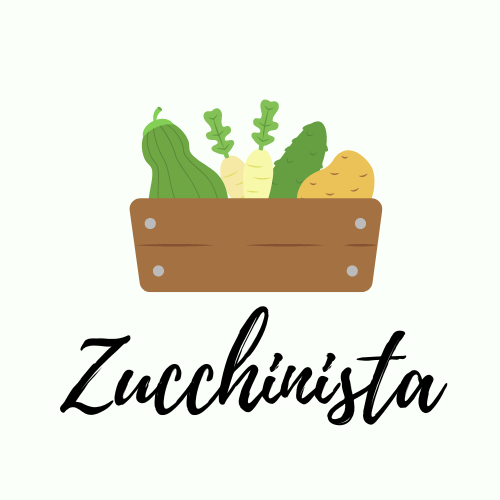The turmeric not only contributes to the incredible golden color, but is also a superfood that contributes to the enrichment with valuable phytochemicals and antioxidants. And with the pumpkin puree you are sneaking an extra portion of vegetables into your seed bread.
It’s so easy and quick to make as there’s no yeast or long fermentation time – just mix the ingredients together and pop it in the oven!
This turmeric pumpkin bread is pleasantly moist thanks to the pumpkin puree. It’s easy to make, super satisfying and absolutely delicious!
In addition to being gluten-free, it is also nut-free, egg-free, dairy-free and vegan! So, even if it’s not exactly low carb, it satisfies most dietary needs.
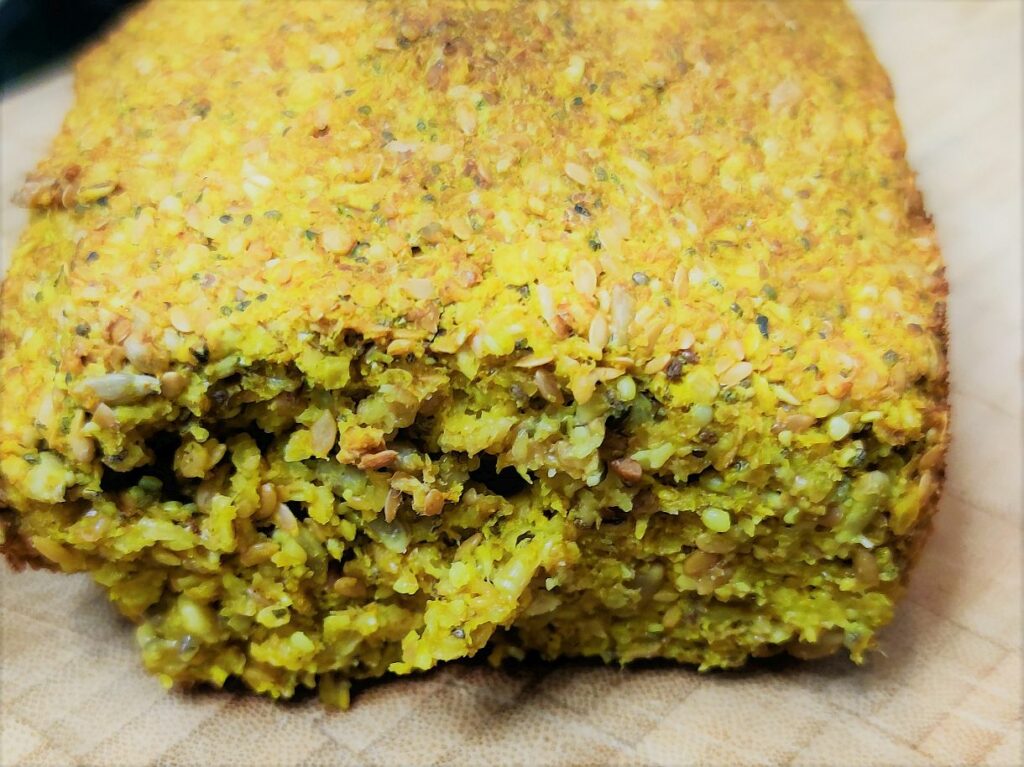
How long does this gluten free bread take to make?
One great thing about this turmeric pumpkin bread is that it can be made so quickly and without much prep time. No yeast or sourdough is used, which takes time to rise – In fact, no leavening agent is used at all. You don’t even need a food processor or hand mixer. Just stir the ingredients together in a bowl, put it in the oven and let the oven do the rest. Thus, the total preparation time is about 70 min., of which just about 10 minutes are active work. The rest of it is baking time!
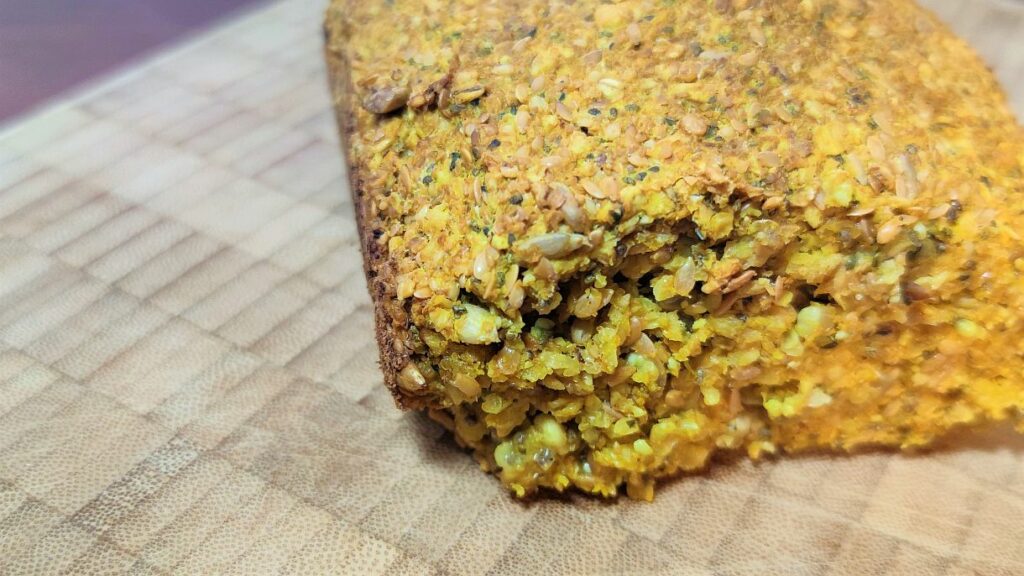
Best ways to enjoy the turmeric pumpkin bread
When it is fresh, the best way to enjoy the turmeric pumpkin bread is just with some butter oder vegan butter and maybe some sea salt flakes sprinkled on top of it.
You may want to serve slices of the turmeric pumpkin bread with all kinds of seed or nut butter.
But it is also perfect for some savoury toppings like parma ham, cured meats or salami.
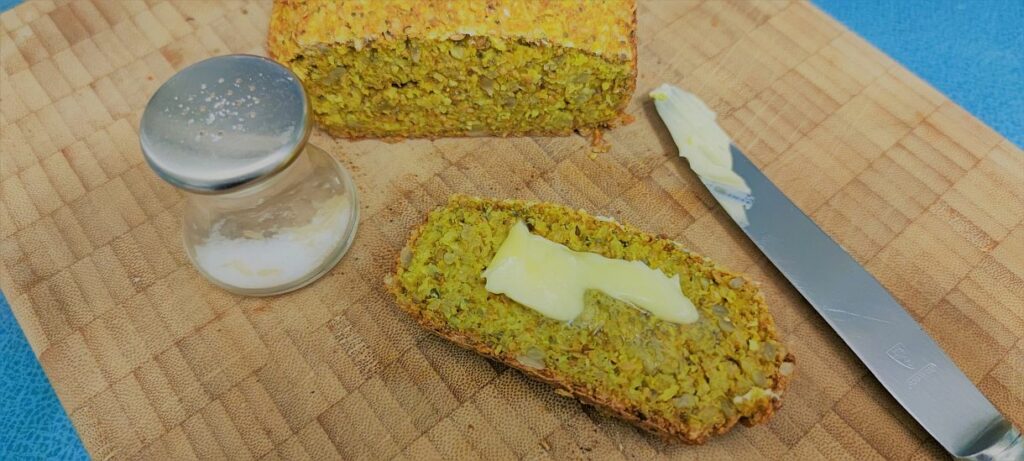
Ingredients – here’s what you need to make turmeric pumpkin bread
- Pumpkin puree – I use thawed pumpkin puree from the freezer. I usually stock up on pumpkin puree during pumpkin season. I am processing the pumpkins from my garden in this way – there is no way to use them all when they ripen (pumpkins are just too fertile). So I build up a nice little stash of pumpkin puree to last through the winter. Anyway, you can use canned pumpkin puree for this recipe, but make sure it is just 100% pumpkin and water and no additional ingredients. This won’t work with canned pumpkin pie filling!
- Oat meal – this recipe calls for small-leaved oatmeal. If there is no need for you to make it gluten-free, you can use standard oatmeal instead.
- Ground gold linseed – I have used whole linseeds here that I have freshly ground. You can buy ground flaxseed in stores here, but they look more coarsely crushed than finely ground. I am a bit sceptical about that, because linseed contains a lot of omega 3 fatty acids and should quickly become rancid when ground and stored. Instead of using gold linseed, you can use the normal, darker variety of linseeds here, but the colour of the pumpkin bread would just not turn out so nicely orange-golden then.
- Sunflower seeds – dehulled sunflower seeds make a nice staple ingredient for gluten free baking. They have a nice nutty flavour, and when baked, their texture comes out just like whole grains.
- Gold linseed – just as with the ground linseed, you can use the dark variety here.
- Hemp seeds – these little seeds are so wonderfully tender and nutty. I have used the white, dehulled form of hemp seeds here.
- Chia seeds – as with linseeds, there is dark and light varieties here. I only had the dark ones at hand, but maybe the white ones would fit even better to this golden turmeric pumpkin bread. Any colour, the nutritional and baking properties of the chia seeds are the same. They don’t fully swell in this recipe but retain a nice little crunch.
- Turmeric powder – besides adding some golden colour and it’s typical warming and comforting flavour, turmeric is packed anti-inflammatory properties and adds to the health benefits of this recipe. But don’t overdo it with the turmeric powder, when overdosed, the flavour becomes slightly unpleasant and soapy.
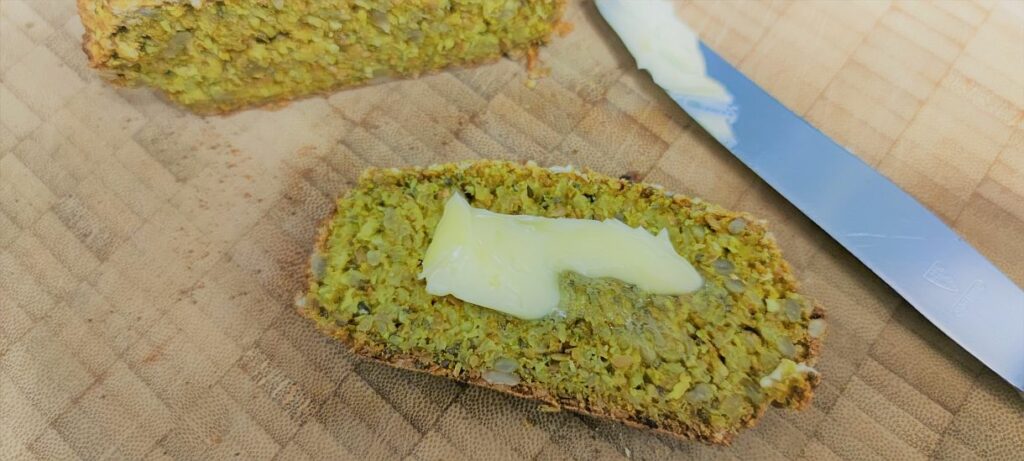
Substitutions and variations
Can I use something instead of pumpkin puree?
You may want to substitute the pumpkin purree with any other kind of pureed starchy or root vegetable. Sweet potato puree or carrot puree may work well (an option would be to use the carrot puree from the small baby jars). But also plain potatoes would work well. Next time you have some leftover mashed potatoes, give it a try.
You can also omit the puree fully and add an adequate amount of water instead.
But the pumpkin puree adds to the texture of the bread and helps to keep it fresh for longer. If you’re just using water instead of the puree, you may need to adjust the amount of water so it doesn’t get too wet and sticky.
Can I use something instead of oatmeal?
I suppose any kind of other grain flakes would work, too. This certainly applies to all types of grain such as wheat, spelt, rye or millet, but also for pseudocereals such as buckwheat or quinoa.
But don’t replace the rolled oats with oat flour or any other kind of (gluten-free) flour or you would have to adjust the amount of liquid.
If you want to go completely grain-free and only want to use flaxseed and other seeds, you would have to revise the ratio of dry and liquid ingredients. Look out for another soon-to-come recipe at this place – but in the meantime I look forward to hearing from you about your variations on the recipe.
Can I substitute the ground linseeds?
You can easily substitute the ground linseeds with ground chia seeds. If you tolerate psyllium husks well, you can substitute a part of the ground linseeds with ground psyllium husks. This will give the bread a more chewy texture and a firmer compound.
Can I use something instead of the sunflower seeds, linseeds, hemp seeds and chia seeds?
Feed free to mix the seeds according to your taste and preference. To be honest, I have used these because they were at hand. I think it is great to mix a variety of bigger and smaller, harder and softer seeds. As this is a pumpkin bread, a great thing to add would be pumpkin seeds. In this composition, the bread is nut-free, but of course you can also add whole, chopped or sliced nuts to the dough.
Can I replace the turmeric?
If you don’t like the taste of turmeric, you can just omit it. The bread will be a bit paler but will still have a nice orange-ish colour thanks to the pumkin.
I you like, you can add some other herbs and spices, like dried rosemary or thyme, or bread spices like fennel, coriander, caraway and anise.
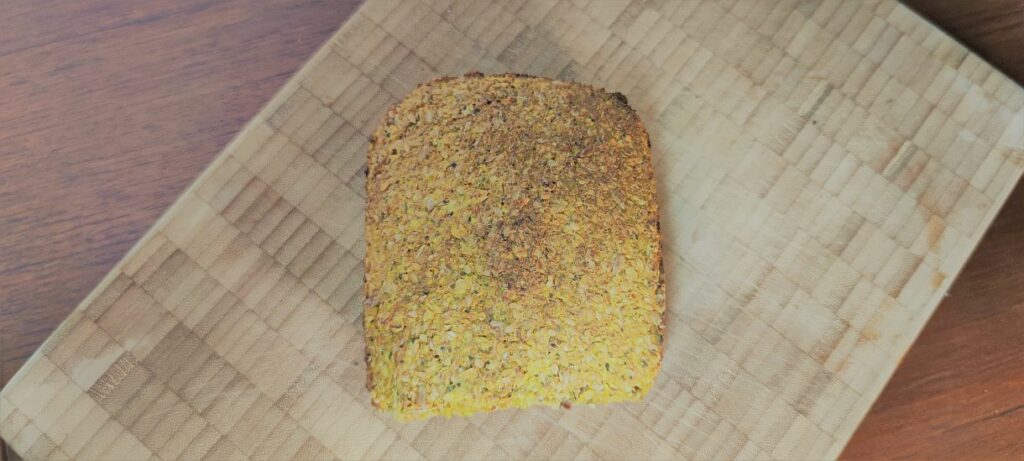
How to store:
Store in the fridge for up to a week, or slice and freeze in an airtight container for up to six months.
To reheat, place the slices in an oven or an air fryer at 180°C until they are warm and crisp, or toast them in a toaster.
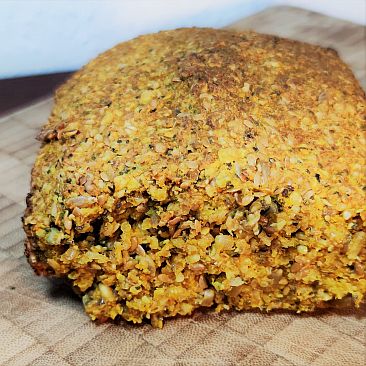
Turmeric Pumpkin Bread
Description
A quick and easy gluten free bread loaf, with a pumpkin twist! This bread loaf is rather dense and hearty like a traditional German wholemeal bread.
Ingredients
Wet ingredients
Dry ingredients
Instructions
-
If you don't have ground linseeds on hand, you can now grind whole linseeds first. You will need 50 g of ground linseeds for this recipe. the best way to grind them is in a small electric coffee grinder, but a food processor will work just as well.
-
Mix the dry ingredients – the oat meal, the ground linseeds and all the different seeds and kernels as well as the salt and turmeric - together in a mixing bowl.
-
Add in the cold water and the pumpkin purree. Whisk to combine the ingredients. Use a spatula or wooden spoon for this.
-
Let it sit for 2-3 minutes, just so that the grains have swollen in the water and the dough has become homogeneous.
-
Grease a baking pan and sprinkle with coconut flour or line the baking pan with parchment paper instead. For this amount of recipe, an 11x21 cm baking pan would be perfect. If you double the recipe, it would be best to use a 13x31 cm loaf pan.
-
Place the dough in the baking pan, form a loaf and smooth the surface with water. Transfer the baking pan to the cold oven Set the oven to 200°C top and bottom heat and bake for approx. 60 minutes until a golden-brown crust has formed.
-
Remove from the baking pan and set on a cooling rack to cool completely.
-
Or at least wait until the bread has cooled enough that it is possible to cut it into slices, but it's just warm enough for the butter you spread on it to melt.
